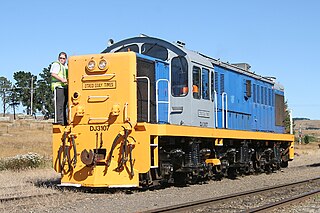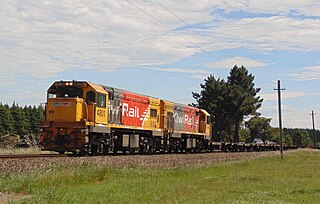
Peter Alan Waterman is an English record producer, songwriter, and television personality. As a member of the Stock Aitken Waterman production and songwriting team, he co-wrote and co-produced many UK hit singles. An avid railway enthusiast, Waterman is the owner of significant collections of both historic and commercial railway locomotives and rolling stock.

TT scale is a model railroading scale at 1:120 scale with a Track gauge of 12 mm between the rails. It is placed between HO scale (1:87) and N scale (1:160). Its original purpose, as the name suggests, was to make a train set small enough to assemble and operate on a tabletop.

Railway preservation in New Zealand is the preservation of historically significant facets of New Zealand's rail transport history. The earliest recorded preservation attempt took place in 1925, although the movement itself did not start properly until 1960.

Hornby Hobbies Limited is a British-owned scale model manufacturing company which has been focused on model railways. Its roots date back to 1901 in Liverpool, when founder Frank Hornby received a patent for his Meccano construction toy. The first clockwork train was produced in 1920. In 1938, Hornby launched its first OO gauge train. In 1964, Hornby and Meccano were bought by their competitor, Tri-ang Railways, and sold when Tri-ang went into receivership. Hornby Railways became independent again in the 1980s, and became listed on the London Stock Exchange, but due to financial troubles reported in June 2017, became majority owned by British turnaround specialist Phoenix Asset Management.

A railfan, rail buff or train buff, railway enthusiast, railway buff or trainspotter is a person who is recreationally interested in trains and rail transport systems.

The BR Standard Class 8 was a class of a single 4-6-2 Pacific steam locomotive designed by Robert Riddles for use by British Railways. Only the prototype was constructed, which was christened the name Duke of Gloucester. Constructed at Crewe Works in 1954, the Duke, as it is popularly known, was a replacement for the destroyed LMS Princess Royal Class locomotive number 46202 Princess Anne, which was involved in the Harrow and Wealdstone rail crash of 1952.

The Fairbourne Railway is a 12+1⁄4 in gauge miniature railway running for 2 miles (3.2 km) from the village of Fairbourne on the Mid-Wales coast, alongside the beach to the end of a peninsula at Barmouth Ferry railway station, where there is a connection with the Barmouth Ferry across the Mawddach estuary to the seaside resort of Barmouth.

A ridable miniature railway is a large scale, usually ground-level railway that hauls passengers using locomotives that are often models of full-sized railway locomotives.

The New Zealand DJ class locomotive is a type of diesel-electric locomotive in service on the New Zealand rail network. The class were built by Mitsubishi Heavy Industries and introduced from 1968 to 1969 for the New Zealand Railways Department (NZR) with a modernisation loan from the World Bank to replace steam locomotives in the South Island, where all of the class members worked most of their lives. Nine of the locomotives remain in use, mainly with Dunedin Railways.

The DQ and QR class were a class of diesel locomotives in New Zealand and Tasmania, Australia. Originally built by Clyde Engineering in the 1960s as Queensland Rail 1460 and 1502 class locomotives, they were purchased by Tranz Rail in 1995 to be rebuilt, as a cheaper alternative to buying new locomotives.

The Railway Enthusiasts Society Incorporated is a New Zealand railway enthusiast society formed on 17 July 1958. RES formed the Glenbrook Vintage Railway (GVR) in 1968, with GVR now forming a separate charitable trust.

The New Zealand DC class locomotive is a type of diesel-electric mainline locomotive on the New Zealand rail network, operated by KiwiRail on freight trains, and formerly on long-distance passenger trains. The class was rebuilt from the DA class in the late 1970s and early 1980s, mainly in Australia. After the DA class, they were the most numerous class of diesel locomotive on New Zealand's railway network and remained numerically dominant until the mid-2010s when withdrawals began.

Steam Incorporated, often abbreviated to Steam Inc., is a railway heritage and preservation society based at the Paekākāriki railway station, Paekākāriki at the southern end of the Kāpiti Coast, approximately 50 minutes north of Wellington on the west coast of New Zealand's North Island. Unlike some societies who operate on preserved sections of closed branch lines, Steam Incorporated owns a depot beside one of the country's most important railway lines, the North Island Main Trunk railway, and restores heritage locomotives and rolling stock for use on excursions on the regular national rail network.
The Railway Correspondence and Travel Society (RCTS) is a national society founded in Cheltenham, England in 1928 to bring together those interested in rail transport and locomotives.
The New Zealand Railway and Locomotive Society Inc is a society of railway enthusiasts, based in Wellington. It was incorporated in 1958.
Frank Roberts was a New Zealand pioneer in building model railways. His models were extremely accurate and reflected the history of the New Zealand railways.
In rail transport modelling, Sn3½ is a scale/gauge combination derived from S scale to represent narrow gauge 3 ft 6 in track by using 16.5 mm gauge track. The scale is 1:64.

The Gisborne City Vintage Railway (GCVR) Incorporated is a railway preservation group based in Gisborne, New Zealand. Operating on part of the northern section of the mothballed Palmerston North–Gisborne Line, the group was founded in 1985. After signing a lease with KiwiRail, Gisborne City Vintage Railway now operates its steam locomotive WA 165 on public excursion trains from Gisborne south to Muriwai, a distance of about 17 kilometres (11 mi). GCVR runs charter and public excursions, mainly from October to June.

NZ120 is a New Zealand variation of the TT scale for model railways using a 1:120 scale with a gauge of 9 mm between the rails, to represent New Zealand's 1,067 mm gauge track.















